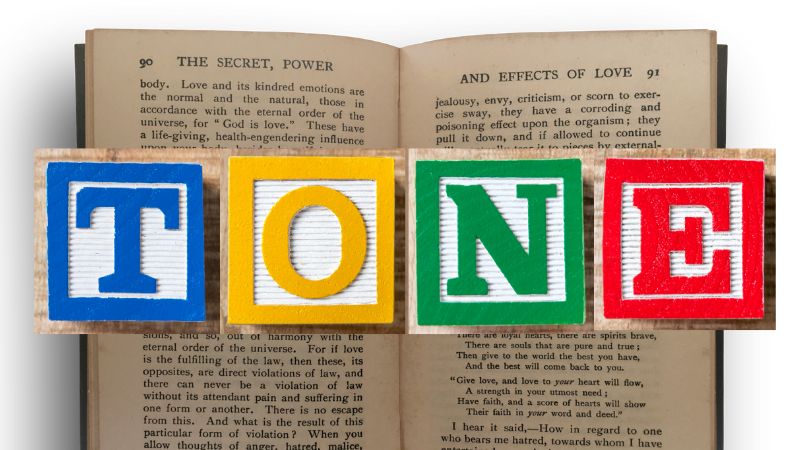In the realm of writing, tone is the hidden language that speaks volumes beyond the words on the page.
It can turn a simple text into a symphony of sentiments, evoking joy, sadness, anger, surprise, and much more.
Tone spans everything from literature to film writing to professional emails in the workplace.
It dictates how your message is received and what kind of an impact your words will have on your audience.
In this post, we’ll uncover the mystery behind the different examples of tone and provide practical insights into how you can deftly weave these tones into your own writing.
So, ready to tune in? Let’s dive deep into the fascinating world of writing tones.
What is Tone?

Tone is an attitude or outlook towards a subject, idea, or event. It can be formal or informal, positive or negative, serious or humorous, etc.
To put it simply, tone is the way you use words to express yourself and convey your message.
It conveys the intended emotion behind the words you choose to write with. Tone encompasses everything from the word choice to syntax and punctuation, all of which contribute to “how” you communicate a message.
But what comes first? The chicken or the egg?
Does your word choice dictate your tone or does your tone dictate your word choice?
Both can be true. The writer’s attitude often dictates their writing style but the author’s word choice can also change the overall tone of their content – whether intentionally or not.
This is why it’s important to be intentional with your literary elements.
Why is Tone Important?
The overall tone of your writing is essential in conveying the right message to your reader. It helps them understand what you’re trying to say and builds a connection between you as the writer and them as the reader.
Your audience will identify with your writing if it resonates with their outlook on life. Conversely, they will be turned off by writing that does not align with their beliefs or personal values.
The tone you use is important for creating a strong relationship between yourself and your readers. It helps them understand who you are, what you stand for, and how they can relate to your message.
27 Examples of Tone
There are many ways to describe a writer’s tone, each conveying a different set of emotions and sentiments.
Here are some of the more commonly used examples of tone:
1. Formal Tone

Formal tone is typically used in professional settings and often appears in legal documents or emails from employers to employees.
It juxtaposes politeness with authority and often requires the use of formal language and terms.
Examples of tone in a formal manner are most often found in the workplace among colleagues and in other professional settings.
Formal tone examples:
- “We are pleased to inform you that your job application has been accepted.”
- “As per the company policy, employees are required to adhere to strict deadlines.”
2. Informal Tone
The informal tone is used in casual conversations between friends or acquaintances.
It can also be used to create a friendly, humorous atmosphere. This tone should not be confused with being unprofessional or disrespectful.
When using an informal tone it’s important to sound natural and authentic. Don’t use complicated words or phrases – use conversational language that anyone can understand. You don’t have to talk in full sentences either – fragments are okay too.
This writing style often includes slang words, abbreviations, colloquialisms, and other informal settings.
Informal tone examples:
- “Hey dude, what’s up?”
- “Check out my new phone! It’s sick!”
3. Serious Tone
The serious tone comes into play when discussing sensitive topics or delivering an important message. It conveys respect and a sense of gravity that must be conveyed in the moment.
When using the serious tone, the language should be confident yet compassionate. This means avoiding words or phrases that could be seen as judgemental or condescending. Instead, use facts to back up statements and avoid any kind of exaggeration.
This type of tone is most commonly used in political speeches and news about serious matters.
Serious tone examples:
- “We are deeply saddened by the passing of John Smith.”
- “The terrorist attacks in Paris have brought to light the urgent need for worldwide peace and security.”
4. Funny Tone

This writing tone is used to lighten up a potentially dull moment or to break through the mundane. Humor can be used to create a connection with the audience, as it creates an intimate atmosphere.
Using this type of tone in writing must be done with caution so that it doesn’t become too over-the-top or offensive—it should always remain appropriate for the brand and its message.
Including an element of wit and charm helps shape how customers perceive the brand and its products.
Funny tone examples:
- “I had a great time at the party last night…or so I’m told.”
- “When life gives you lemons, make lemonade – and don’t forget the tequila!”
5. Positive Tone
The positive tone of an author’s voice is one that is enthusiastic, upbeat, and optimistic. It is also generally friendly and cheerful.
The positive tone conveys enthusiasm and optimism to the reader, often inspiring them to take action or be hopeful.
Positive tones often have a warmer feel than neutral tones, making them well-suited to create trust and build relationships with customers.
They can be used to express excitement or enthusiasm about a product or service, as well as to emphasize the positive aspects of a company or brand.
Positive tones can be used to show appreciation for customers, announce promotions and new products, and provide helpful customer support.
Positive tone examples:
- “Let’s make this project a success!”
- “This year will be full of great opportunities – let’s make the most of them!”
6. Negative Tone
The negative tone of an author’s voice is one that is downbeat, pessimistic, and often filled with criticism. It can also be used to express frustration or contempt.
Negative tones should generally be avoided in business writing, as they can reflect poorly on the brand and create a sense of negativity or hostility in the reader.
However, it may be appropriate in some cases to address negative topics or criticism, such as when a customer service issue needs to be resolved.
Negative tones should always remain polite and professional, even when addressing difficult topics.
Negative tone examples:
- “Your performance in this project was unacceptable.”
- “This behavior needs to change immediately.”
7. Playful Tone
This lighthearted tone is perfect for lightening up a conversation or adding some humor into your writing. It often makes use of puns, metaphors, hyperboles, and other creative language.
When writing with a playful or witty tone, it’s important to be mindful of the audience and use appropriate language. It should be used in moderation and not overwhelm other tones that you’re using.
It can be helpful to take a step back and re-read your work every once in awhile to make sure it follows the brand voice guidelines you have set up for your writing.
Playful tone examples:
- “Life is like a box of chocolates – you never know what you’re gonna get!”
- “The future isn’t far away; it’s just around the corner.”
8. Inspirational Tone

The inspirational tone aims to motivate and inspire its readers. It often employs phrases that evoke hope and courage, as well as words of encouragement.
This tone should be used sparingly, as it can easily come across as corny or self-aggrandizing. It’s important to maintain a balance between expressions of enthusiasm and sincerity.
Make sure your messages are genuine and uplifting. Inspire readers by emphasizing the benefits of acting on their goals and dreams with positive statements.
For example, when writing product descriptions, highlight how it can make life easier or more fun rather than just listing features. Encourage readers to imagine a better future for themselves and their lives after using the product.
Inspirational tone examples:
- “Anything is possible if you believe in yourself.”
- “The only way to succeed is to keep on trying even when the odds are against you.”
9. Sarcastic Tone
Sarcasm is often adopted in order to make a point or express emotion. It often uses irony and wit when delivering the message, but should be done carefully as it can also come off as rude.
Sarcastic language should be kept light-hearted and never used in an aggressive manner.
Sarcastic tone words should only be employed if the situation warrants it, and it should always be used sparingly.
Sarcastic tone examples:
- “Oh, great! Another project I get to work on at 3 AM.”
- “Right on time again – what a surprise!”
10. Pessimistic Tone
A pessimistic tone reveals a lack of hope or enthusiasm. It can be used to express disappointment with the current state of affairs, as well as doubt in the success of future endeavors.
of should be used sparingly and only when appropriate. It may be appropriate in some cases to address negative topics, such as when a customer service issue needs to be resolved.
When used, it should always remain polite and professional, even when addressing difficult topics.
Pessimistic tone examples:
- “I’m afraid this situation is beyond repair.”
- “It’s impossible to reach our goals with the current resources available.”
11. Optimistic Tone
The opposite of pessimism is optimism. This type of tone reveals a sense of hope and enthusiasm for the future. Optimistic tone words can help to motivate others and inspire them to take action.
Optimistic tone examples:
- “We can achieve our goals if we work together.”
- “This is a great opportunity to try something new!”
11. Aggressive Tone

The aggressive tone is one that expresses anger or hostility. It should be avoided in most cases, as it can come off as hostile and unwelcoming.
When aggressive tone words are used, they should always remain professional and polite.
Aggressive language should not be employed unless absolutely necessary.
Aggressive tone examples:
- “You need to make this happen – right now!”
- “I’m not asking, I’m telling you.”
13. Neutral Tone
The neutral tone is one that avoids emotion or opinion. It is often used when writing reports or providing factual information.
This type of writing should be concise and free from any bias. It should also include accurate facts and figures to provide the reader with an objective view of a situation.
Neutral tone examples:
- “This could be a good opportunity for both parties.”
- “What do you think about this issue?”
14. Respectful Tone
The respectful tone is one that shows respect for the reader and their opinions. It uses polite language and avoids any harsh words or criticism.
This writing style should be professional and courteous, as it can help to build good relationships with customers or colleagues.
It can also show humility and appreciation for the other person’s views or experiences.
Respectful tone examples:
- “I appreciate you taking the time to listen to my proposal.”
- “Thank you for your kind words of encouragement.”
15. Persuasive Tone

The persuasive tone is one that attempts to convince or persuade the reader.
It should use logical arguments and evidence to support its claims, as well as emotional language to try to evoke a response from the reader.
This type of writing needs to be carefully crafted, as it can easily come across as aggressive or manipulative if done incorrectly.
Persuasive tone examples:
- “The evidence speaks for itself – this is the right decision to make.”
- “This is the best option for getting what you want.”
16. Casual Tone
This type of tone conveys a sense of familiarity with readers and invites them to engage in an easy-going conversation.
Casual writing often contains words like “you” or “we” to make it more friendly and approachable, as if you’re having a conversation with the reader.
It’s often used for blog posts and social media updates, as it can help build relationships between brands and customers.
Using casual language is an effective way to make customers feel like they are part of something bigger, that they are accepted in the brand’s environment.
Casual tone examples:
- “Hey there! What’s up?”
- “Let’s grab some coffee later – sound good?”
17. Urgent Tone
The urgent tone is one that conveys a sense of urgency or importance. It’s often used to emphasize the need for immediate action and should be used sparingly.
When used in the right context, urgent tone words can be effective in motivating people and helping them understand why they should take action.
However, overusing this type of language can sound overly aggressive and can diminish its impact.
Urgent tone examples:
- “We need to act on this immediately!”
- “This issue has to be addressed now!”
18. Friendly Tone
The friendly tone is one that conveys a sense of warmth and openness. It should be used to create a positive atmosphere and make customers feel valued and welcome.
This type of writing should be informal, but still professional. Use words like “we”, “you”, and “our” to address the others directly.
Examples of tone in a friendly way are most often found with acquaintances or new relationships.
Friendly tone examples:
- “I really appreciate your help with this project.”
- “Thank you for being so understanding!”
19. Empathetic Tone

An empathetic tone helps to make your others feel understood. This type of tone can convey that you truly care about their needs and concerns, making them more likely to build a positive relationship with you.
When using an empathetic tone, use words like “understand” and “feel” to let others know that you are listening.
Empathetic tone examples:
- “I understand how difficult this time must be for you.”
- “My heart goes out to you during this difficult time.”
20. Supportive Tone
The supportive tone is one that conveys a sense of encouragement and understanding.
It should be used to show your support for the reader, even if they don’t agree with you on certain topics or issues.
This type of writing is often used to build relationships and motivate people, as it can help strengthen their resolve and boost their morale.
Supportive tone examples:
- “I’m here to offer you any help I can.”
- “My goal is to provide you with all the support you need.”
21. Confident Tone
The confident tone is one that conveys a sense of assurance and certainty. It should be used to demonstrate authority and give the reader a feeling of security.
This type of writing should include language that instills trust in the reader, such as words like “certain”, “guarantee”, and “assurance”.
Confident tone examples:
- “I can affirm that this is the right decision.”
- “I’m certain we can make this a success!”
22. Assertive Tone
The assertive tone is used to demonstrate authority and assertiveness. It often requires the use of strong language and forceful words.
Assertive writing should be used sparingly, as it can come across as overly aggressive if not handled properly.
Assertive tone examples:
- “This has to be done now, no exceptions.”
- “I expect this to be completed by the end of the day.”
23. Hopeful Tone
The hopeful tone is one that conveys optimism and positivity. It should be used to encourage and motivate the reader to keep striving towards their goals.
This type of writing can help lift people’s spirits and give them the confidence they need to stay on track.
Hopeful tone examples:
- “I have faith that we can make this happen.”
- “We are optimistic that we can find a solution.”
24. Calm Tone

The calm tone is used to bring peace and tranquility to the reader. This tone is used when delivering information, expressing empathy, and creating a relaxed environment.
It’s important to use this tone sparingly since overuse can lead to boredom, confusion, and ultimately disinterest in the message.
When using a calm tone, think about how you would talk to a friend or family member during a difficult time: with sincerity and respect.
Use language that is comforting and soothing, avoid unnecessary details, and focus on common ground between the message sender and receiver.
Calm tone examples:
- “I wish you peace and serenity in this time of challenge.”
- “May all beings find tranquility and harmony within their hearts.”
25. Constructive Tone
Constructive tone emphasizes solutions, constructive actions, and progress.
It should be used when providing feedback or making suggestions that are intended to improve a situation or idea.
When using this tone, it is important to remain respectful and focus on the positive elements of the solution being proposed.
Use language that is positive and actionable rather than negative and destructive.
Constructive tone examples:
- “Let’s think about how we can make this better.”
- “I’m sure we can find a way to move forward with this project.”
26. Surprised Tone
Examples of tone for surprise normally express surprise or shock. This type of writing should be used sparingly and only when appropriate, as it can come across as overly dramatic or aggressive.
When using this tone, use language that conveys the intensity of the situation without sounding incendiary.
Surprised tone examples:
- “That’s quite a surprising development!”
- “I can’t believe this is happening!”
27. Encouraging Tone
Examples of tone for encouragement provide support and motivation to its readers. It uses positive language to encourage readers to take action or be hopeful.
This writing tone is often used to inspire and motivate the reader. It can also be used to boost morale or provide a positive outlook on a difficult situation.
Encouraging tone examples:
- “You have what it takes to make this happen!”
- “Believe in yourself – you can do it!”
How to Identify Tone in Writing
Identifying tone in writing can be tricky, but with practice, it’s possible to identify a wide range of tones used by different authors.
Here are some tips on how to identify tone:
- Read the text carefully and pay attention to the words used, the sentence structure, and even punctuation.
- Pay close attention to adjectives – they can often reveal the tone of an author.
- Look for patterns or recurring themes – these may help you identify a particular tone.
- Use context clues to understand the overall message and determine the writer’s intent.
- Finally, try to think of how you would feel if you were reading the text yourself – this can also help you identify tone in writing.
With practice, you can become a master at recognizing tone and creating pieces with the perfect tone for your audience.
How to Use Tones in Writing
Using the right tone in your writing is a great way to ensure that your message resonates with readers. Here are some tips on how to use different tones in writing:
Know Your Audience
Before you start writing, take the time to understand who you are addressing and what kind of impact you want to have on them.
This will help you pick the right tone for your message. For example, formal tone in the workplace and informal tone with your friends and family.
Choose Your Words Carefully
Every word carries a certain connotation and plays an important role in setting the tone of your writing.
Take the time to pick the words that best communicate what you are trying to convey.
Use Emotional Language
Emotional language helps to drive your point home and increase the impact of your writing.
Try using words that evoke positive or negative emotions (joy, sadness, anger etc.) depending on what you are aiming for.
Vary Your Tone
It’s important to be consistent when using tone in writing but don’t be afraid to mix things up once in a while.
Combining different types of tones can make your writing more interesting and engaging for readers.
Remember That They Can’t See You
In writing, particularly online or in email, you are not speaking face to face. No one can see your facial expression or your body language.
Try to convey the same level of emotion as if you were talking to someone in person and avoid using a tone that may be interpreted as overly harsh.
FAQs About Tone
Conclusion
Having the right tone in your writing is essential to connecting with readers and conveying your message in the most effective way.
When you’re writing, your audience can’t read your body language – they can only receive your tone in writing. This is why your word choice is so important because it can also dictate the tone of your writing.
Knowing how to change your overall tone in writing will help you create content that resonates with a wide range of audiences.
By understanding your audience, choosing your words carefully, using emotional language, varying the tone, and remembering that people can’t see you, you can ensure that your writing is powerful and effective.
If you’re not sure which tone to use in a particular situation, take some time to think about the overall message you want to convey.
Then use the examples of tone and tips above to find the right balance of tones for your writing. With practice and patience, you’ll be able to master the art of using different tones in writing.